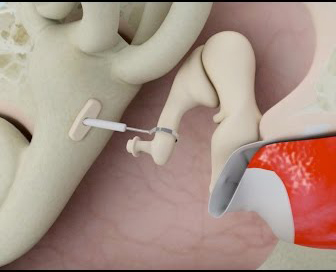Your ear is divided into three parts, outer ear which consists of pinna and auditory canal, middle ear which consists of three bones (Malleus, Incus and Stapes) and the inner ear which consists of chochlea. Stapedectomy is performed through the ear canal with the help of specially designed microscope and instruments. Your doctor will make an incision in the lining of the auditory canal and will extend that to the ear drum or tympanic membrane. The incision will extend around the tympanic membrane to set it free, and this allows it to be lifted and thus leaves middle ear exposed.After exposing the middle ear, your surgeon will scrape out the extra bone tissue to clear the field of view while ensuring no damage being done to the nerve carrying taste inputs to your tongue.
Stapedectomy is performed through the ear canal with the help of specially designed microscope and instruments. Your doctor will make incision in the lining of auditory canal and will extend that to the ear drum or tympanic membrane. The incision will extend around the tympanic membrane to set it free and this allows it to be lifted and thus leaves middle ear exposed.After exposing the middle ear your surgeon will scrape out the extra bone tissue to clear the field of view while ensuring no damage being done to the nerve carrying taste inputs to your tongue.
After exposing the middle ear your surgeon will scrape out the extra bone tissue to clear the field of view while ensuring no damage being done to the nerve carrying taste inputs to your tongue. After stapes has been exposed, your doctor will use laser to set it free from Incus and finally will also release it from its footplate. Footplate helps in transmitting audio signals from middle ear to inner ear. Your surgeon will now make a hole in the footplate , the prosthesis will now be placed into the fooplate and the other end will be clipped to incus (the middle bone). After the prosthesis has been secured, your surgeon will put tympanic membrane back to its previous position and will secure its position with the help of absorbable gelatin bandage.







